Wednesday Walk: American Prefident
My unexpected quest to decipher thrift store gold from worthless garbage
Welcome to Willoughby Hills!
As is typical every Wednesday, today I’m bring you a smattering of topics that I hope will make you a bit more curious about the world around you and give you something to think about later.
If you like what you’re reading, you can sign up to have this newsletter delivered to your inbox every Wednesday and Sunday for free:
Good News, Bad News, Who Can Say?
Happy Wednesday folks and thank you as always for reading! This week started with some unexpected news.
When I commute into Boston these days, I prefer to drive to the closest subway station and then take an MBTA train into the city. Usually, this means parking at the Alewife station, which is the last stop on the red line in Cambridge.
However, Alewife station is closed for at least a week after an incident this past weekend. Apparently, a car plowed into a concrete wall in the parking garage, causing the concrete to tumble through the glass atrium and into the station below.
One person suffered minor injuries, but it could have been much worse. More unsettling, the incident is being described by investigators as “intentional,” although no further information was given.
Even though I follow a lot of local news and public transit advocacy accounts on Twitter, I somehow didn’t hear about the station’s closure until I was trying to park there on the way to work Monday morning. I arrived to a closed parking garage, roped off by caution tape, and I suddenly had to find a new way to the office on short notice.
I decided that rather than be frustrated or mad at the incident, I would see it as an opportunity. There’s an orange line station about a 10 minute drive from Alewife and that line had recently put new train cars into service that I hadn’t yet had a reason or opportunity to ride. I could go park at that station and would have a chance to ride the new train cars! An unexpected win, in the face of what felt like a loss.
Here’s a few photos and thoughts on the new trains, for those who are interested.
The new trains are quiet and very comfortable. They are outfitted with overhead LED signage that showed upcoming station, plus flatscreen monitors that give station and transfer information.
The seating on the new cars is spaced a little further apart than I remember on the older trains or on other lines. I could comfortably sit and hold a book in front of me without rubbing elbows with my neighbor.
The train also has several areas where the seats are hinged and automatically flip up into the wall like a theatre seat, plus areas with no seating installed at all, creating little nooks outside of the main aisle. This allows more space for wheelchairs, strollers, and bikes, plus also gives people more room when there’s a standing room crowd at rush hour. It’s another example of universal design benefitting everyone.
But perhaps the best part about riding the orange line is that it’s above ground for most of the journey, only going underground right before entering Downtown Boston. I enjoy the increased daylight and views that come with being above ground on the orange line, even if sometimes the scene is fairly unremarkable. Even the most mundane view is more exciting than a dark tunnel!
What started with the seeming bad news of Alewife station’s closure turned into good news by changing up my routine and getting to experience the newest subway cars in Boston.
I’m reminded of an old Buddhist fable which Jay Shetty recounted in his book Think Like a Monk. I won’t quote the full version here, but I found a succinct version from Evelyn Theiss:
“A Chinese farmer gets a horse, which soon runs away. A neighbor says, ‘That's bad news.’ The farmer replies, ‘Good news, bad news, who can say?’
The horse comes back and brings another horse with him. Good news, you might say. The farmer gives the second horse to his son, who rides it, then is thrown and badly breaks his leg.‘So sorry for your bad news,’ says the concerned neighbor. ‘Good news, bad news, who can say?’ the farmer replies.
In a week or so, the emperor's men come and take every able-bodied young man to fight in a war. The farmer's son is spared.
Good news, of course.”
What we think of as good news or bad news in a moment is often not what it seems when looking at the big picture. Ever since I first heard that story, I’ve tried to carry that spirit with me and look for ways to see the good news even in what seems like bad news at the time.
Geo Wafhington
Last week when I was in Nashua, New Hampshire, (a trip which inspired Sunday’s column), I stopped into a Savers thrift store to see what was on the shelf.
If you’ve been reading this newsletter for a while, you know that I can be a sucker for thrifted dishware, but I also love browsing for books, CDs, records, and anything else quirky and vintage.
As I was wandering through the dishware department, I happened upon this pitcher. It really stood out to me and I had to snap a photo:
I liked the design of the pitcher, although the name above the portrait said “Geo. Wafhington” and the insignia below read “Long Live the Prefident of the United States.”
The typesetter seemed to have replaced the letter s with the letter f twice, although strangely enough, the lower case s in “States” remained as it should be. Beyond that, using the phrase “Long Live” to describe a long dead president seemed to lack American cultural awareness. What I thought was a funky vintage piece that was maybe 40-50 years old suddenly looked more like a cheap import that hadn’t been proofread very well.
I opted not to buy the pitcher, but instead decided to post the photo above to my social media accounts, thinking others might get a chuckle out of these strange typos.
To my surprise, a lot of people commented about how they wanted this pitcher and what an amazing find it was.
Judith on Twitter said:
“I bought Real Carnival glass at Good Will for $3 I sold it at a consignment shop for $400 and they told me the Woman who bought it gushed over what a bargain it was”
Were Judith and I even looking at the same item?! She seemed to think I had struck gold, but I thought I found a cheap knockoff.
But then I saw Stacey’s message on Twitter, which made me wonder if I had misjudged this piece entirely:
“Amazing, the Germanic S(f) is used… definitely a collector item”
It turns out that the use of f in place of s was not a typo at all! Embarrassingly for me, I didn’t realize that this style of writing was once common, historic, and is even used in the U.S. Constitution.
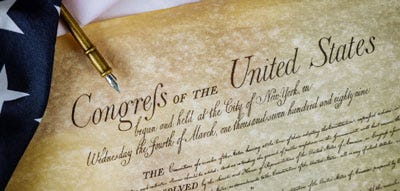
Here’s how Marissa Laliberte from Reader’s Digest described the use of an f-like character in our nation’s founding document:
“Let’s get one thing out of the way: That F-like letter is not an actual F. It’s called a long S (ſ). Unlike a lowercase F, the horizontal line doesn’t strike all the way through but only goes on the left side. In some cases, like the glaring example of “Congreſs” in the Bill of Rights, there’s no bar at all.
The long S was pronounced just like a normal (short) S, and its history dates back to the first century when Romans used an early form of it when writing quickly in cursive. When a standardized script was developed for Europe in the eighth century, the ſ/S distinction stayed intact.”
According to Grammarly, the long s was in use until the late 1700s and almost completely disappeared from popular use by the early 1800s, a remarkably swift decline considering it had been in use for more than 1,000 years at that point!
George Washington served as president until 1797 and died in 1799, which means that the font on this pitcher was historically accurate. But is there any chance this was historically authentic too? I started doing some more online sleuthing to see.

It turns out that there’s a similar pitcher in the collection of the Smithsonian! It’s not an exact match to what I saw at Savers, but feels like a close cousin.
The New York Historical Society Museum and Library also has a similar pitcher in their collection featuring Washington. Theirs was manufactured in China in the early 1800s. According to that museum, these vessels were known as “cider pitchers” which were used to serve cider or low alcohol beer.
Apparently, this style of pitcher was very common around the turn of the 19th century, although according to Smithsonian, they were rarely American in origin:
“…It is characteristic of wares made in large volume for the American market in both Staffordshire and Liverpool between 1790 and 1820. Pitchers of this shape, with a cream colored glaze over a pale earthenware clay, known as Liverpool type, were the most common vessels to feature transfer prints with subjects commemorating events and significant figures in the early decades of United States’ history. Notwithstanding the tense relationship between Britain and America, Liverpool and Staffordshire printers and potters seized the commercial opportunity offered them in the production of transfer printed earthenwares celebrating the heroes, the military victories, and the virtues of the young republic, and frequently all of these things at once.”
The Smithsonian also notes Washington was a frequent muse for printers, especially at the time of his death:
“George Washington is the most common figure depicted on English creamware pitchers of this period. His death in 1799 led to an outpouring of commemorative products celebrating his life and mourning his death.”
Was it possible that this pitcher on the shelf at Savers was actually a British artifact produced during Washington’s lifetime, at a time when the letter s didn’t look like the letter s?!
Even though I hadn’t bought the pitcher, I was plotting to go back to the store. I could imagine myself as the star of an upcoming episode of Antiques Roadshow with quite the story to tell. My kids’ college fund might be paid for by President Wafhington!
There was only one certain way for a mortal like me to assess the value and true progeny of this piece: search on eBay.
The first result I found was not much help. It listed the price at $12.99, plus another $14 for shipping, but the photos showed no brand name that I could search, and the only information in the listing was that it had “no issues” (very helpful).
I found another one listed for $18.00, but this one had the words I was dreading: “reproduction” and “circa 1970s.”
According to the seller, the pitcher was meant to mimic the Liverpool style of porcelain. It was not a true original, but a newer version imitating something old (hence the use of the long s). The seller dated it from the 1970s, which makes sense given the huge amount of merchandise created for America’s Bicentennial in 1976, although I’m not sure how the seller arrived at that date for this piece beyond intuition.
At any rate, it seemed that the pitcher at Savers was worth less than $20. A dud.
Except the mystery wasn’t over. As I scrolled eBay, I saw one more listing. This one was not identical, but it was very close to the others, and it was selling for $125.00 (plus $47 in shipping costs, presumably for lots of bubble wrap)!
I suppose the lesson in all of this is that value is completely in the eyes of the buyer and seller. A priceless antique sold at a prestigious auction house for tens of thousands of dollars could have a twin somewhere in the world selling for $5 at a yard sale.
Large manufacturers and retail stores try to have some pricing standards for new products, but at the end of the day, an item is worth exactly what the buyer is willing to pay and the price at which the seller is willing to part with the piece.
Thank you for reading! I always love hearing your thoughts, so please drop a line in the comments.
I publish new issues every Wednesday and Sunday. Sign up to always receive the latest issue and support my work:
Other Wednesday Walks
Please consider sharing this with a friend that you think might enjoy it or you can post it on social media.
If you’ve missed past issues of this newsletter, they are available to read here.
Stay Safe!
Heath


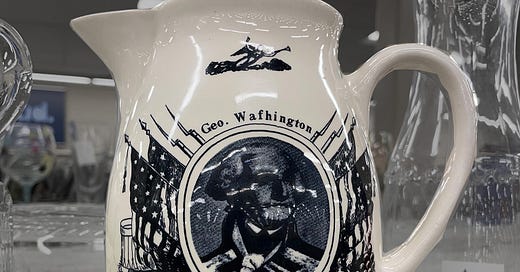

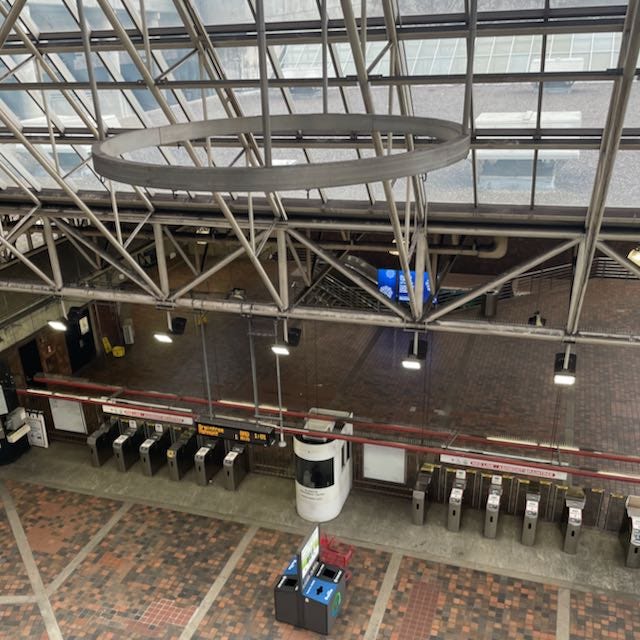




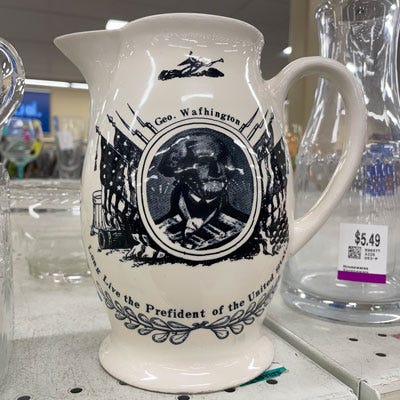

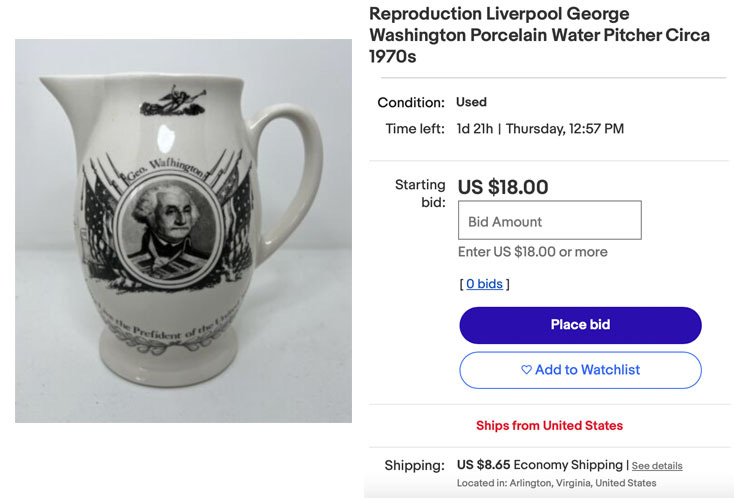
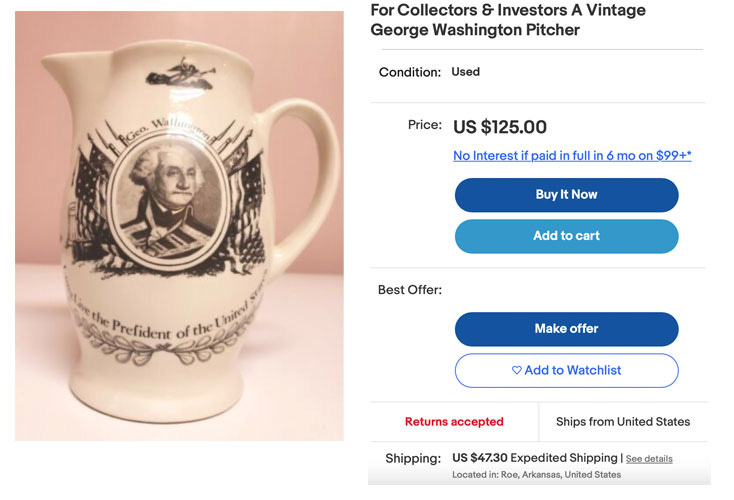
I was surprised that the pitcher in New York History Museum was made in China.
Anyone who said they knew about the s f thing is lying and you can’t convince me otherwise!